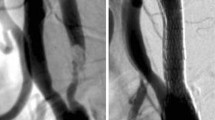Abstract
The authors report a syndrome of regional, symptomatic cerebral hyperperfusion, and edema mimicking infarction in a 54-year-old woman following coiling of a ruptured right carotid bifurcation aneurysm and stenting of the right middle cerebral artery. The patient presented with a Hunt and Hess grade III subarachnoid hemorrhage 7 days after developing thunderclap headache. She underwent successful coiling under general anesthesia of the 1.6 × 1.5 × 1.6 cm aneurysm, but immediately after the coil was placed occlusion of the proximal M1 segment was developed. This occlusion was stented after ~5-min delay, and flow restored without angiographic evidence of distal emboli. Following the procedure, she was extubated and noted to have left hemiparesis, neglect, and mutism without a CT correlate. Cerebral infarction was suspected, but urgent repeat angiography demonstrated patent cerebral vasculature. On the following day, symptoms persisted, and non-contrast head CT now showed cerebral edema localized to the right middle cerebral artery territory mimicking subacute infarction. CT perfusion imaging and angiography showed a widely patent MCA circulation, and suggested a regional hyperperfusion syndrome. The blood pressure was incrementally lowered, with rapid and sustained neurological improvement. Hyperperfusion events following aneurysm repair and related circumstances are reviewed.




Similar content being viewed by others
References
Maruya J, Nishimaki K, Minakawa T. Hyperperfusion syndrome after neck clipping of a ruptured aneurysm on a dolichoectatic middle cerebral artery. J Stroke Cerebrovasc Disord. 2011;20:260–3.
Penn AA, Schomer DF, Steinberg GK. Imaging studies of cerebral hyperperfusion after carotid endarterectomy. Case report. J Neurosurg. 1995;83:133–7.
Kaku Y, Yoshimura S, Kokuzawa J. Factors predictive of cerebral hyperperfusion after carotid angioplasty and stent placement. AJNR Am J Neuroradiol. 2004;25:1403–8.
Fujimura M, Shimizu H, Mugikura S, Tominaga T. Delayed intracerebral hemorrhage after superficial temporal artery-middle cerebral artery anastomosis in a patient with moyamoya disease: possible involvement of cerebral hyperperfusion and increased vascular permeability. Surg Neurol. 2009;71:223–7. discussion 7.
Wartenberg KE, Parra A. CT and CT-perfusion findings of reversible leukoencephalopathy during triple-H therapy for symptomatic subarachnoid hemorrhage-related vasospasm. J Neuroimaging. 2006;16:170–5.
Vasquez RA, Waters MF, Skowlund CJ, Mocco J, Hoh BL. Computed tomographic perfusion imaging of non-hemorrhagic cerebral hyperperfusion syndrome and reversal following medical treatment after carotid artery angioplasty and stenting. J Neurointerv Surg. 2012;4(3):e2.
Karapanayiotides T, Meuli R, Devuyst G, et al. Postcarotid endarterectomy hyperperfusion or reperfusion syndrome. Stroke. 2005;36:21–6.
Scozzafava J, Hussain MS, Yeo T, Jeerakathil T, Brindley PG. Case report: aggressive blood pressure management for carotid endarterectomy hyperperfusion syndrome. Can J Anaesth. 2006;53:764–8.
Voetsch B, Tarlov N, Nguyen TN, et al. Asymmetric posterior reversible encephalopathy syndrome complicating hemodynamic augmentation for subarachnoid hemorrhage-associated cerebral vasospasm. Neurocrit Care. 2011;15:542–6.
Fujimoto S, Toyoda K, Hirai Y, et al. Serial evaluation of acute cerebral hyperperfusion by transcranial color-coded sonography. Ultrasound Med Biol. 2006;32:659–64.
Jarus-Dziedzic K, Glowacki M, Warzecha A, Jurkiewicz J, Czernicki Z, Fersten E. Cerebrovascular reactivity evaluated by transcranial Doppler sonography in patients after aneurysmal subarachnoid haemorrhage treated with microsurgical clipping or endovascular coiling technique. Neurol Res. 2011;33:18–23.
Moulakakis KG, Mylonas SN, Sfyroeras GS, Andrikopoulos V. Hyperperfusion syndrome after carotid revascularization. J Vasc Surg. 2009;49:1060–8.
Piepgras DG, Morgan MK, Sundt TM Jr, Yanagihara T, Mussman LM. Intracerebral hemorrhage after carotid endarterectomy. J Neurosurg. 1988;68:532–6.
Komoribayashi N, Ogasawara K, Kobayashi M, et al. Cerebral hyperperfusion after carotid endarterectomy is associated with preoperative hemodynamic impairment and intraoperative cerebral ischemia. J Cereb Blood Flow Metab. 2006;26:878–84.
Suga Y, Ogasawara K, Saito H, et al. Preoperative cerebral hemodynamic impairment and reactive oxygen species produced during carotid endarterectomy correlate with development of postoperative cerebral hyperperfusion. Stroke. 2007;38:2712–7.
Sfyroeras GS, Karkos CD, Arsos G, et al. Cerebral hyperperfusion after carotid stenting: a transcranial doppler and SPECT study. Vasc Endovasc Surg. 2009;43:150–6.
Sundt TM Jr, Sharbrough FW, Piepgras DG, Kearns TP, Messick JM Jr, O’Fallon WM. Correlation of cerebral blood flow and electroencephalographic changes during carotid endarterectomy: with results of surgery and hemodynamics of cerebral ischemia. Mayo Clin Proc. 1981;56:533–43.
Solomon RA, Loftus CM, Quest DO, Correll JW. Incidence and etiology of intracerebral hemorrhage following carotid endarterectomy. J Neurosurg. 1986;64:29–34.
Iihara K, Okawa M, Hishikawa T, et al. Slowly progressive neuronal death associated with postischemic hyperperfusion in cortical laminar necrosis after high-flow bypass for a carotid intracavernous aneurysm. J Neurosurg. 2010;112:1254–9.
Sugino T, Ohtaki M, Wanibuchi M, Kin S, Houkin K. Hyperperfusion syndrome after clipping an unruptured cerebral aneurysm: two case reports. Neurol Med Chir (Tokyo). 2010;50:306–9.
Araki Y, Andoh H, Yamada M, Nakatani K, Andoh T, Sakai N. Permissible arterial occlusion time in aneurysm surgery: postoperative hyperperfusion caused by temporary clipping. Neurol Med Chir (Tokyo). 1999;39:901–6. discussion 6–7.
Kuroki K, Taguchi H, Yukawa O. Hyperperfusion syndrome after clipping of an unruptured aneurysm. Case report. Neurol Med Chir (Tokyo). 2006;46:248–50.
Murakami T, Ogasawara K, Yoshioka Y, et al. Brain temperature measured by using proton MR spectroscopy predicts cerebral hyperperfusion after carotid endarterectomy. Radiology. 2010;256:924–31.
Jung JE, Kim GS, Chen H, et al. Reperfusion and neurovascular dysfunction in stroke: from basic mechanisms to potential strategies for neuroprotection. Mol Neurobiol. 2010;41:172–9.
Amin-Hanjani S, Schwartz RB, Sathi S, Stieg PE. Hypertensive encephalopathy as a complication of hyperdynamic therapy for vasospasm: report of two cases. Neurosurgery. 1999;44:1113–6.
Sanelli PC, Jacobs MA, Ougorets I, Mifsud MJ. Posterior reversible encephalopathy syndrome on computed tomography perfusion in a patient on “Triple H” therapy. Neurocrit Care. 2005;3:46–50.
Jang HW, Lee HJ. Posterior reversible leukoencephalopathy due to “triple H” therapy. J Clin Neurosci. 2010;17:1059–61.
Giraldo EA, Fugate JE, Rabinstein AA, Lanzino G, Wijdicks EF. Posterior reversible encephalopathy syndrome associated with hemodynamic augmentation in aneurysmal subarachnoid hemorrhage. Neurocrit Care. 2011;14:427–32.
Iihara K, Murao K, Sakai N, Yamada N, Nagata I, Miyamoto S. Outcome of carotid endarterectomy and stent insertion based on grading of carotid endarterectomy risk: a 7-year prospective study. J Neurosurg. 2006;105:546–54.
Author information
Authors and Affiliations
Corresponding author
Rights and permissions
About this article
Cite this article
Ecker, R.D., Murray, R.D. & Seder, D.B. Hyperperfusion Syndrome after Stent/Coiling of a Ruptured Carotid Bifurcation Aneurysm. Neurocrit Care 18, 54–58 (2013). https://doi.org/10.1007/s12028-012-9733-x
Published:
Issue Date:
DOI: https://doi.org/10.1007/s12028-012-9733-x




